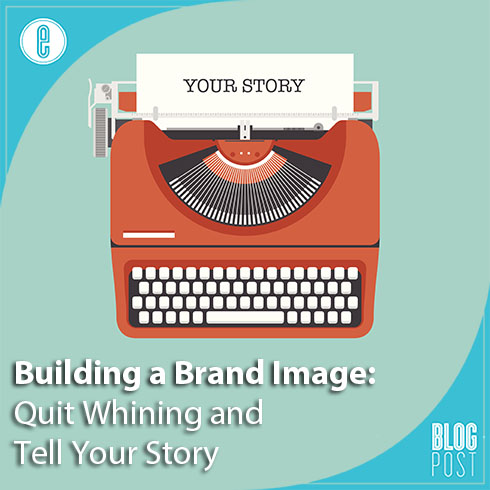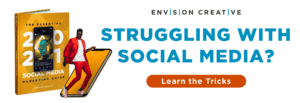
Sometimes companies come to us stumped by the fact that, while their newest marketing initiative is “working” (content marketing increased website traffic, or direct mail brought in more phone calls, or a holiday discount temporarily upped sales), they can’t seem to convert or retain their customers.
The part that always kills me is that, despite being amazing, unfailingly interesting people, the confused individuals who sit in our conference room never consider that they may have shoehorned their company into a dry and boring marketing limbo — too afraid to offend with the opinions that built the company, too cautious to give their brand personality, and much too convinced that numbers will always speak more than imagery or words.
These companies are refusing to tell their story — to create a brand that connects with people.
Branding & Marketing: So Romantic
There’s a reason that Envision Creative Group invests itself into the branding of its clients just as much as the marketing: it’s the only way that we can ensure success.
Marketing is nothing more than a friendly introduction. When Envision is in the digital realm breaking down website metrics, carefully crafting emails, and refining the targeting of social ads, we’re only working to get you  in front of the right person.
in front of the right person.
If, on that first date, your company’s interactions are generic and boring, and you have no means of connecting with that individual, our effort is going to waste.
Your brand is what makes your company relatable: it’s your opinions, your thoughts, your choice of style, and the risk you have to take to win your customers over. It’s what gets you seen from across the room, and it’s that magical ingredient that keeps the conversation going late into the night.
You’re not the only company in your industry. Your audience knows that. Show them how unique you are.
Great Storytelling Establishes an Emotional Connection
In a recent Entrepreneur article, “Storytelling Can Bring Your Brand to Life and Strengthen Your Marketing Impact,” we’re reminded that, while people often forget details, they always remember the way that stories make them feel. While great marketing storytellers don’t completely ignore product features, they don’t dwell on them either, aiming to make an emotional connection with their audience.
Think about it: people don’t buy Coca-Cola for its ingredients, and often not even its taste. Rather, they do it out of tradition or nostalgia; they associate Coca-Cola with time spent with family or the act of “sharing a moment.” Take a look at any Coca-Cola commercial, including this gem from 1979, and you will find the formula hasn’t changed much: successful marketing evokes raw, relatable emotion through stories that may be as short as a few words (not that words are even necessary).
Likewise, people don’t buy Michael Kors purses for the features. They do it for status, and for the way that owning a luxury product makes them feel.
In fact, some have found that, no matter how “rational” we try to be, human beings rely on emotion for every decision. This argument comes from a study involving individuals that had a biological disconnect between the rational and emotional part of their brains. Even though these people were able to logically acknowledge the significance of different choices, they had trouble making decisions because they couldn’t determine how they felt about their choices. They were stuck in a fog of ambivalence that most of us unconsciously use emotion to break out of.
But let’s get real for a second: You’re not Coca-Cola.
You’re likely not selling a consumer-facing product that reaches thousands of people at a time. It’s much more likely that you’re selling niche B2B products or services. But the rules still apply.
B2B and Storytelling
HubSpot, a quickly growing marketing automation giant, is a prime example of how a B2B company can succeed through telling a story.
Sure, its software is jam-packed with features that make marketers drool, but HubSpot understands that features won’t sell a product on their own.
Every company’s product has “great features.” And the truth is that, in the marketing automation industry, for example, the most successful companies are not necessarily going to have the “best” or “all” of said features.
Jump into a hosted webinar, read an interview with CEO Brian Halligan, or scan a few pages of its website, and you will quickly learn that Hubspot succeeds because it isn’t afraid to talk about how it came to be: through firsthand experience in the industry.
HubSpot’s products and services are given a purpose, fueled by one big, cohesive story that its customers can relate to:
- As a marketer, what does it feel like to put in months of hard work without being able to prove ROI?
- As a salesperson, how does it feel to spend most of your day intrusively cold-calling businesses without any results?
- As a business, what does it feel like to be on the other end, receiving hordes of email spam on a daily basis?
Rather than creating a product, HubSpot created an emotionally fueled movement, called “Inbound Marketing,” that just happens to be supplemented by a product. If you look deep enough, you’ll find that the term “inbound marketing” was invented by the founders of HubSpot (check out Google trends), yet hordes of competing SaaS companies describe themselves as “inbound marketing automation software” providers.
HubSpost wasn’t afraid to take the risk.
Tips for Effective Storytelling
Here are some tips for using storytelling in your own inbound marketing campaigns:
- Tell the truth: You don’t have to tell your own story; telling the customer their story can be just as effective. No need to lie!
- Don’t let the story end: Concern yourself with the way customers feel after they make a purchase, and keep them close. Do any of your products continue the story?
- Know who you’re talking to: Even if your customers are in the same industry, they have different job roles and motivations. Don’t just know who buys your products, but know why, and highlight the parts of your story that they can relate to most.
- Tell more than one story: Don’t get too caught up telling your own story. Realize that you are creating an entirely new one for your customer, too. Present them with a pain point that they didn’t know they had, give them a solution that they didn’t know existed.
There is no marketing without a brand. And there is no brand without a story. Every company has one to tell. Quit whining and go tell it.
-FINAL(01-00)-White&Blue-01.svg)




